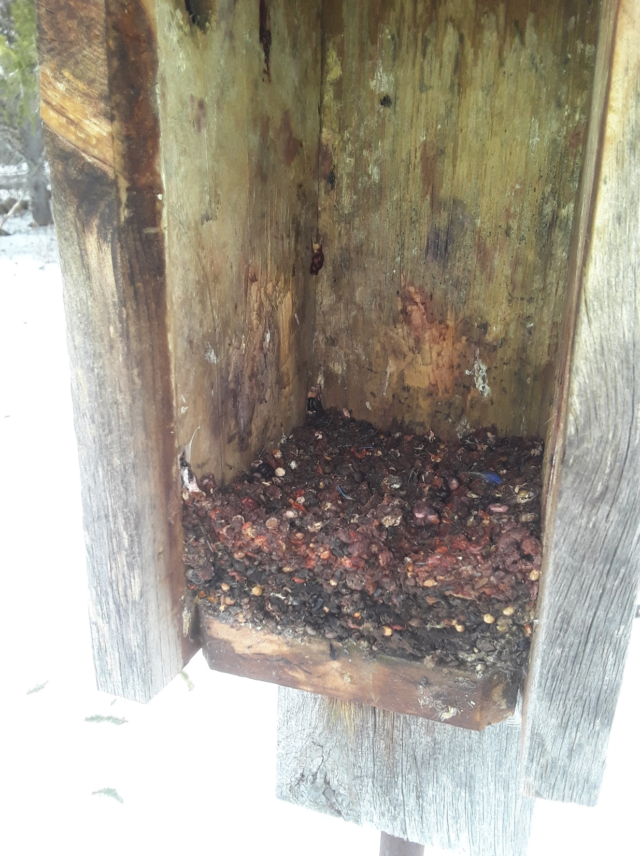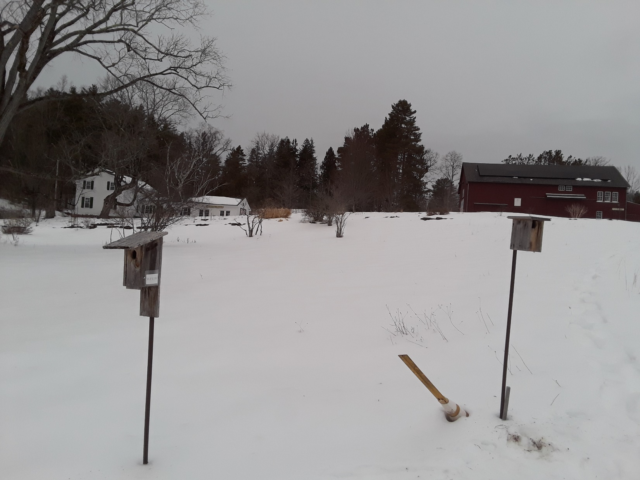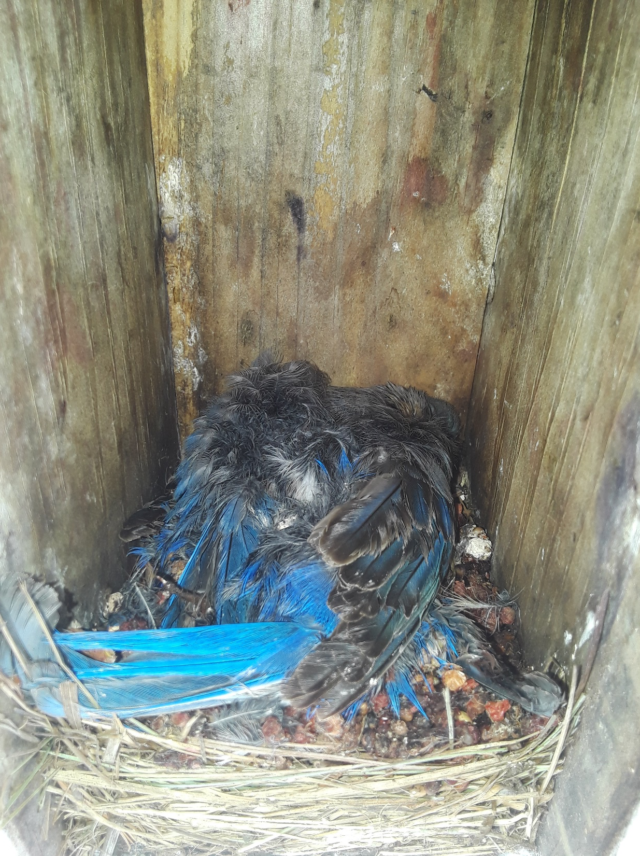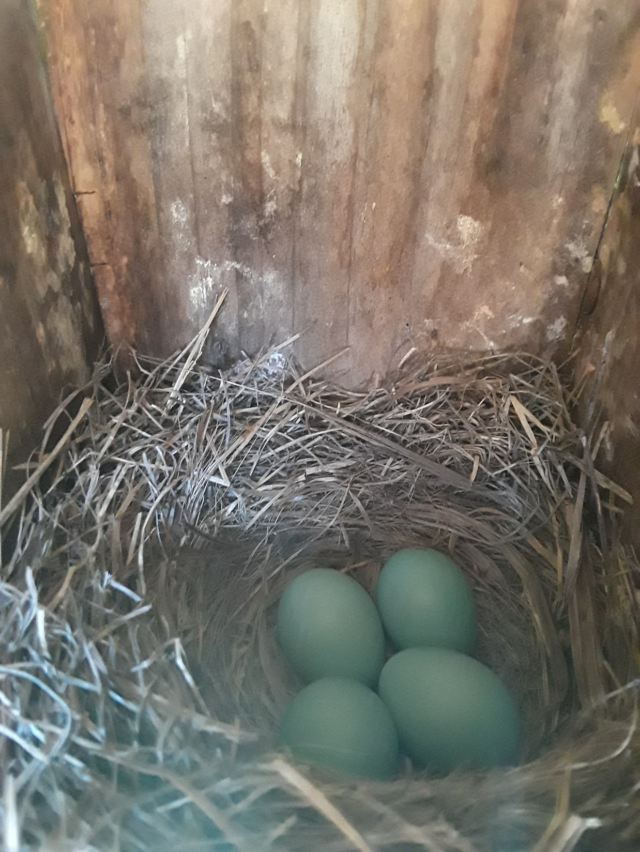Please submit any comments, questions, or suggestions to birding@landisarboretum.org.
News from the Trail
Trail monitoring report
All nest monitoring is conducted in accordance with The Cornell Lab of Ornithology’s Nestwatch Nest Monitoring Manual. All monitoring data is entered into the Nestwatch database, and an end-of-year summary is also submitted to the New York State Bluebird Society. If you’d like to follow along with our Bluebird Trail Map, please open https://landisarboretum.org/assets/images/Landis-Bluebird-Trail.jpeg .
All nest boxes were inspected and cleaned out in late August after nesting ended. This was repeated in late February. A few boxes required repairs--mainly the roofs, which bear the brunt of the weather. The February checks also confirmed that overwintering birds were roosting in many of the boxes.

The above photo taken on February 25 shows a thick layer of seeds that were deposited in box WT3W by one or more roosting birds. A lot of it looks like sumac. If you look very closely you might be able to see abluebird feather. Some birders collect these seeds and plant them to help propagate more fruiting plants that help feed birds and other animals during wintertime when food is harder to come by. If you see seeds left in your own nest boxes when you do your preseason box check/clean out then why not collect them, plant them and see what you get. The birds will thank you.
Last fall Fred and I reviewed the 2024 nest box results to see who was nesting where. We found that some box locations that didn’t host bluebirds were being encroached upon by brush and trees. The bluebird trail was created about 25 years ago so it is no surprise that this would happen. While this isn’t necessarily a deal breaker for bluebirds, these now brushy locations become attractive to House Wrens. Wrens can be very aggressive and may outcompete bluebirds for a favored box location. The National Audubon Society estimates that the population of House Wrens is 4.5 times greater than the combined populations of Eastern Bluebirds and Tree Swallows, so we’d prefer that these latter two species use our nest boxes. With that in mind, some areas were brush hogged last fall where that was feasible and desirable. Also, several boxes were moved to locations that are more open. In addition, we expanded the bluebird trail by adding four new boxes to the field next to the Waterfall Trail parking lot. This increases our nest box total to 44.
Routine monitoring will begin during March. Last year was a record year at the Arboretum for bluebirds. Hopefully, our bluebird trail will do as well this year. Much depends on the weather.
Classes/Field Trips
There are many bird-related classes and field trips scheduled for 2025. These include Setting Up a Bluebird Nest Box, Annual Spring Hawk Watch & Hawk Identification Workship, three Bluebird Trail Walks, Sounds Of Spring Nature Walk, Morning Bird Walk, Early Birding - A Birding Workshop For Kids, Sunrise Celebration Nature Walk, Bird Feeder Making Workshop, and the Annual Halloween Owl Prowl. These events start in early March and go through late October. Visit ourUpcoming Events webpage to see details and to sign up. If there are other classes or field trips you’d like to see, please email us your ideas.
Bluebird Lottery
2024’s Bluebird Lottery was a success with good participation and winners receiving lots of free prizes. So, we are repeating the lottery again this year. Find information about last year’s lottery in 2024 editions of the Bluebird Blog. Please visit our Upcoming Events webpage to learn how to participate in the 2025 lottery.
Featured Bird

Baltimore Oriole – The whistling song of the Baltimore Oriole is one of the sounds of spring in our part of the world. They are a little smaller than robins. Males are bright orange and black. Females and immature males are yellow-orange and grey. They like to eat fruit, nectar and insects, and can be attracted to backyard feeders if you put out fruit, jelly, nectar or mealworms. Baltimore Orioles prefer open deciduous woodland andforest edges, often perching at the tops of trees. I’ve seen them bathing in the Shanti-Vun Meditation Garden waterfall a number of times. You can learn much more about Baltimore Orioles by visitinghttps://www.allaboutbirds.org/guide/ .
Muse for the Trail
Countless songs have been written about birds. Listed below are several examples that are worth a listen. You can find these for free on Youtubeand elsewhere. The lyrics range from literal to metaphorical andallegorical, and some are just instrumental pieces.
“Arboretum” by Prince. How can you pass up a song with a name like that? Prince loved doves and had two of his own. He credited his doves, Majesty and Divinity, on this short 2002 piano instrumental. If you’d prefer something more up tempo by Prince then listen to “When Doves Cry”.
“Birdhouse In Your Soul” by They Might Be Giants. On the surface it’s an ode to a blue canary-shaped night light but there is much more to it than that.
“The Eagle and the Hawk” by John Denver. He sure could belt them out when he wanted to.
“Blackbird” by The Beatles. This very gentle song was sung by Paul McCartney. It is an allegory of the 1960’s civil rights movement. For a completely different song that shares the same title, listen to “Blackbird” by Noni.
“Il Gardellino” (The Goldfinch) Concerto Op. 10 No. 3 in D by Vivaldi. A flute imitates the European Goldfinch.
“Fly Like an Eagle” by Steve Miller Band. The theme of this song is social justice and the good feeling you get from helping others. Try the “Space Intro - Fly Like an Eagle” version with headphones on. The artist Seal recorded a cover of this song that is also worth a listen.
“Sparrow” by Marvin Gaye. A song inspired by a failed relationship.
“The Baldoon Goose” by Tanglefoot. A folk song about lifting a witch’s curse.
“Bird Set Free” by Sia. A song of self-empowerment.
Random Facts and Helpful Hints
Spring migration is underway! Some species are returning to our area to stay until autumn and others are passing through on their way further north. This is a great time to go birding. Visit https://www.audubon.org/news/wave-theory-of-bird-migration to learn more about spring migration.
Quarterly Boggler
How did Baltimore Orioles get their name?
(see answer at bottom of page)
Nestbox Spotlight

Location WPT1, downhill from the Farmhouse and Barn. Box WPT1E is on the right. This, and the photograph that follows, were taken on February 25, 2025.

This is a photo of the inside of box WPT1E which, although sad, is instructive. First, some bluebirds don’t migrate south in the winter. Second, these bluebirds had built an incomplete nest here after the nesting season had ended (and following the late August box cleanout). In my research, I couldn’t find an explanation for this behavior though it appears to be uncommon. I wonder if they started a nest to lay claim to the box in advance of the next nesting season or if its purpose was to provide some insulation for roosting during cold weather. Third, on top of the nest is a layer of seeds that have been deposited by the birds. The thickness of this layer indicates that this box was commonly used for roosting. Finally, on top of the seeds is a female bluebird and, on top of her, a male. There was no sign of predation, so the cause of death is likely starvation, hypothermia or disease. I would guess either starvation or hypothermia though they often go hand-in-hand. Bluebirds have enough feathers to keep them warm in wintertime if they can get enough food and if they are able to stay dry and out of severe winds. You may recall that this winter was rather harsh and there was a long period in mid-February with high winds, freezing rain, snow, and extreme wind chill caused by back-to-back storms. Those conditions make it very difficult for birds to find food and survive.
Below, bluebird eggs in this same nest box, May 2024. All eggs hatched and the young fledged. Hopefully, we’ll see one or more of them return to this box in the spring.

Boggler Answer
Lord Baltimore was the first Proprietor of Maryland from 1632-1675. Thebirds share the same colors as his family’s heraldic crest. In the 1700’s an English naturalist visiting America documented that these birds were locally referred to as “Baltimore Birds”. Sometime later they were named Baltimore Orioles. New World orioles were named after similar-looking Old World birds, though they are not closely related.
